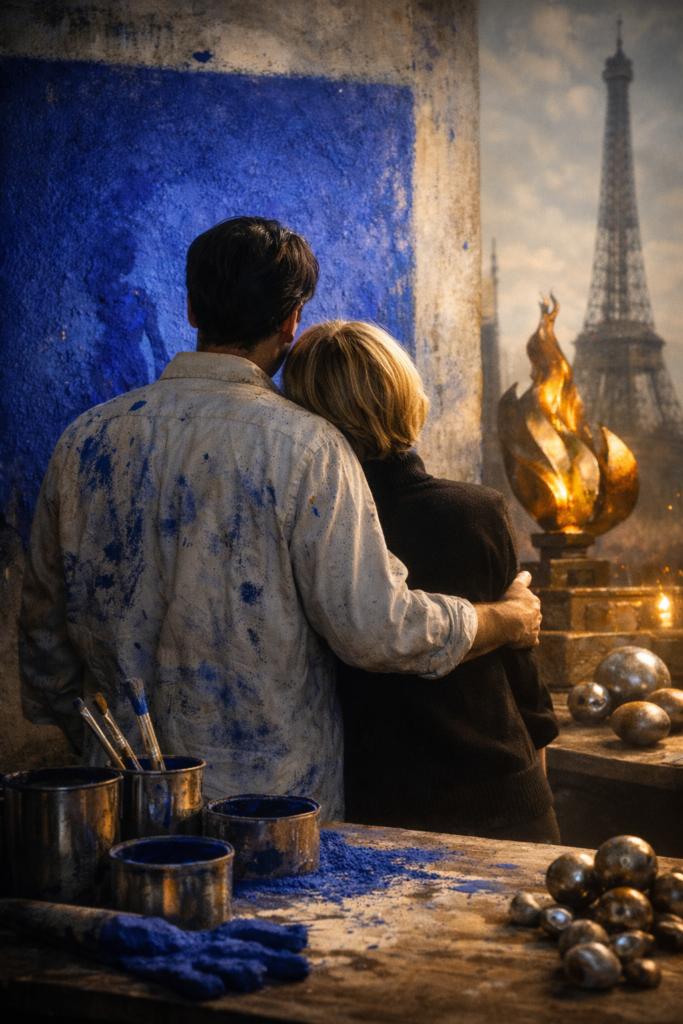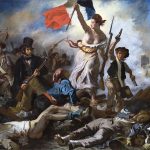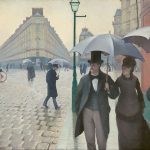
Yves Klein, born on April 28, 1928, in Nice, France, is celebrated as one of the most innovative and provocative artists of the 20th century. His work transcends traditional artistic boundaries, blending elements of painting, performance, and conceptual art. Klein is perhaps best known for his development of International Klein Blue (IKB), a deep, vibrant blue that became his signature color. This shade wasn’t just a hue for Klein; it was a manifestation of his vision, a portal to the infinite.
Klein’s artistic journey began in earnest in the late 1940s. Influenced by his background in judo and his interest in mysticism, he sought to break free from conventional artistic practices. His work often incorporated unorthodox materials and methods, such as using human bodies as “living brushes” to create his Anthropometries series. This series, featuring nude models covered in blue paint pressing their bodies against canvas, challenged traditional notions of art-making and highlighted Klein’s belief in the immateriality of art.
His monochrome paintings, particularly those in IKB, are central to his legacy. These works are not merely about color but about conveying a sense of the infinite and the void. As Klein himself once said, “Blue has no dimensions; it is beyond dimensions.” This quote encapsulates his philosophy and his quest to transcend the physical limitations of art.
Klein’s career, although tragically short—he died at the age of 34 in 1962—left an indelible mark on the art world. His bold ideas and innovative techniques continue to inspire and influence artists across various disciplines. His legacy is not just in the works he created but in the boundaries he pushed, challenging artists to see beyond the visible and explore the unseen.
The Meeting of Minds: Klein and Uecker
The story of Yves Klein cannot be fully told without mentioning Rotraut Uecker, his wife and artistic partner. Uecker, born on October 14, 1938, in Rerik, Germany, is an accomplished artist in her own right. The couple met in 1957, during one of Klein’s exhibitions in Paris, and their connection was immediate and profound. This meeting marked the beginning of a deep personal and professional partnership that would influence both of their artistic journeys.
At the time of their meeting, Uecker was an emerging artist, eager to find her voice in the vibrant Parisian art scene. Klein, already making waves with his radical approaches, saw in Uecker a kindred spirit. Their shared passion for pushing the boundaries of art and their mutual fascination with the immaterial and spiritual aspects of creativity formed the bedrock of their relationship.
Their collaboration extended beyond their personal life into their artistic practices. Uecker became an integral part of Klein’s creative process, often participating in his performances and contributing to his projects. This partnership was not one-sided; Uecker’s own work began to reflect the influence of Klein’s ideas, particularly his emphasis on the immaterial and the infinite.
Klein and Uecker’s relationship exemplified the synergy that can exist between two creative minds. Their union was not merely about companionship but about a shared vision and a collaborative spirit. They supported and challenged each other, pushing the boundaries of their respective practices. This dynamic partnership enriched their individual artistic outputs and left a lasting impact on the art world.
Rotraut Uecker: An Artist in Her Own Right
While often associated with Yves Klein, Rotraut Uecker’s artistic achievements stand firmly on their own. Her journey as an artist began before she met Klein and continued to flourish after his untimely death. Uecker’s work is characterized by its exploration of form, color, and the interaction between space and light. She has developed a unique visual language that distinguishes her from her contemporaries.
Uecker’s early works were influenced by the minimalist and kinetic art movements. She experimented with various materials and techniques, creating pieces that engaged the viewer’s perception and interaction. Her sculptures, in particular, are known for their elegance and their ability to transform the spaces they inhabit. Uecker’s use of light and shadow adds a dynamic quality to her work, making it seem as if her pieces are constantly in motion.
After Klein’s death, Uecker continued to develop her artistic practice, delving deeper into her interests in form and space. Her works from this period reflect a maturity and confidence that comes from years of exploration and experimentation. Uecker’s ability to create works that are both visually stunning and conceptually rich has earned her recognition and respect in the art world.
In addition to her sculptures, Uecker has also made significant contributions to painting and installation art. Her use of bold colors and abstract forms demonstrates a mastery of her craft and a keen understanding of the interplay between color and emotion. Uecker’s works invite viewers to contemplate and engage, offering a sensory experience that goes beyond the visual.
Uecker’s career is a testament to her resilience and dedication to her art. Despite the challenges and tragedies she faced, she remained committed to her creative vision. Her work continues to be exhibited in galleries and museums around the world, inspiring new generations of artists and art lovers alike. Rotraut Uecker is not just Yves Klein’s widow; she is a formidable artist whose contributions to the art world are significant and enduring.
The Power of International Klein Blue
International Klein Blue (IKB) is more than just a color; it is a cultural and artistic phenomenon. Developed by Yves Klein in collaboration with chemists, IKB is a deep ultramarine blue that has become synonymous with Klein’s artistic legacy. This unique shade of blue holds a special place in the history of modern art, representing both a technical achievement and a philosophical statement.
Klein’s fascination with blue stemmed from his desire to create works that evoked the infinite and the immaterial. He believed that blue had the ability to transcend physical boundaries and evoke a sense of boundlessness. In his words, “Blue has no dimensions; it is beyond dimensions.” This belief drove him to develop a pigment that could capture the intensity and purity of blue without being diluted by binders or mediums.
The development of IKB was a meticulous process. Klein worked with chemists to create a resin binder that would preserve the pigment’s brilliance and luminosity. The result was a color that seemed to radiate from within, a blue that was both vibrant and ethereal. Klein’s use of IKB in his monochrome paintings and Anthropometries series created a visual impact that was both striking and contemplative.
IKB’s influence extends beyond Klein’s own works. The color has been adopted and adapted by numerous artists, designers, and fashion houses, becoming a symbol of innovation and creativity. Its unique properties and the philosophical ideas it represents continue to inspire new generations. The power of IKB lies not just in its visual appeal but in its ability to evoke a sense of wonder and transcendence.
Klein’s legacy through IKB is a reminder of the profound impact that a single color can have on the art world. It challenges us to see beyond the surface and to explore the deeper meanings and emotions that colors can convey. IKB is more than just a hue; it is a gateway to the infinite, a symbol of Klein’s enduring vision and creativity.
Collaborative Works and Performances
The partnership between Yves Klein and Rotraut Uecker extended into their artistic practices, resulting in collaborative works and performances that highlighted their shared vision. These joint endeavors were not just about creating art but about exploring the boundaries of artistic expression and the interaction between the material and the immaterial.
One of the most notable collaborations was the Anthropometries series, where Uecker played a crucial role. In these performances, nude models, often including Uecker, were coated in IKB and used their bodies to imprint the pigment onto canvas. These living brushes created dynamic, abstract compositions that were both performative and painterly. The process of creating these works was as significant as the final product, emphasizing the role of the body in art-making and the ephemeral nature of the creative act.
Klein and Uecker’s collaborative spirit also extended to their involvement in various art movements and exhibitions. They were active participants in the Nouveau Réalisme movement, which sought to bridge the gap between art and life by incorporating everyday objects and materials into artworks. This movement, founded by Pierre Restany in 1960, included artists who, like Klein and Uecker, challenged traditional artistic conventions and explored new modes of expression.
Their performances often blurred the lines between artist and artwork, creator and creation. In one such performance, “Sculpture Aérostatique” (1960), Klein released 1,001 blue balloons into the sky, transforming the atmosphere into a living sculpture. This event exemplified Klein’s fascination with the immaterial and the transient, themes that resonated deeply with Uecker’s own artistic explorations.
The collaborative works and performances of Klein and Uecker are a testament to their innovative spirit and their willingness to challenge artistic norms. Their partnership enriched their individual practices and left a lasting impact on the art world. By working together, they were able to push the boundaries of what art could be, creating works that were both visually compelling and conceptually profound.
Legacy and Influence
The legacy of Yves Klein and Rotraut Uecker is far-reaching, influencing countless artists and movements across the globe. Klein’s radical ideas and Uecker’s innovative practices have left an indelible mark on contemporary art, challenging artists to think beyond traditional boundaries and explore new modes of expression.
Klein’s monochromes, particularly those in International Klein Blue, continue to inspire artists who seek to explore the emotional and conceptual potential of color. His use of the human body as a tool for creating art has also had a lasting impact, influencing performance artists and those who use the body as a medium for expression. Klein’s work has been celebrated in numerous retrospectives and exhibitions, solidifying his place as a pioneer of modern art.
Uecker’s influence is equally significant. Her sculptures, paintings, and installations have been exhibited in major galleries and museums worldwide, earning her recognition as a leading figure in contemporary art. Her ability to transform space through her use of form and light has inspired architects and designers, bridging the gap between art and architecture. Uecker’s work continues to evolve, reflecting her ongoing exploration of new materials and techniques.
The couple’s collaborative works and performances have also left a lasting legacy. Their innovative approaches to art-making have inspired artists to experiment with new methods and to see the creative process as a dynamic and interactive experience. The themes of immateriality and the infinite, central to both Klein and Uecker’s works, continue to resonate with artists and audiences alike.
Their influence extends beyond the art world, impacting fashion, design, and popular culture. The use of IKB in fashion and design is a testament to the enduring appeal of Klein’s vision. Uecker’s contributions to design, particularly her exploration of light and form, have influenced contemporary design practices and aesthetics.
Klein and Uecker’s legacy is a testament to their innovative spirit and their willingness to push the boundaries of art. Their work challenges us to see beyond the surface, to explore the deeper meanings and emotions that art can convey. Their influence continues to inspire and challenge artists, encouraging them to explore new possibilities and to push the boundaries of what art can be.
Conclusion
The story of Yves Klein and Rotraut Uecker is one of collaboration, innovation, and profound artistic vision. Together, they challenged traditional artistic conventions and explored new modes of expression, leaving an indelible mark on the art world. Klein’s development of International Klein Blue and his use of the human body as a tool for creating art have had a lasting impact, inspiring artists across various disciplines. Uecker’s innovative practices and her ability to transform space through her use of form and light have earned her recognition as a leading figure in contemporary art.
Their collaborative works and performances exemplify the synergy that can exist between two creative minds. Their partnership enriched their individual practices and left a lasting legacy that continues to inspire and challenge artists. The themes of immateriality and the infinite, central to both Klein and Uecker’s works, resonate with audiences and artists alike, encouraging them to explore new possibilities and to push the boundaries of what art can be.
In the words of Yves Klein, “To paint space, I must position myself outside space.” This quote encapsulates the visionary approach that both Klein and Uecker brought to their work. Their ability to see beyond the physical limitations of art and to explore the deeper, immaterial aspects of creativity is what makes their legacy so enduring and influential. The story of Yves Klein and Rotraut Uecker is a testament to the power of collaboration, the importance of innovation, and the enduring impact of visionary artistic practices.




